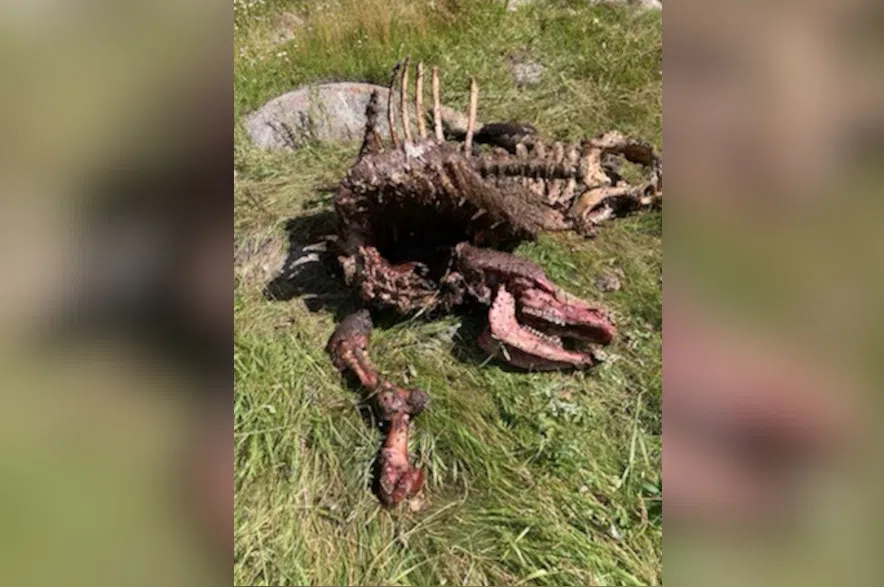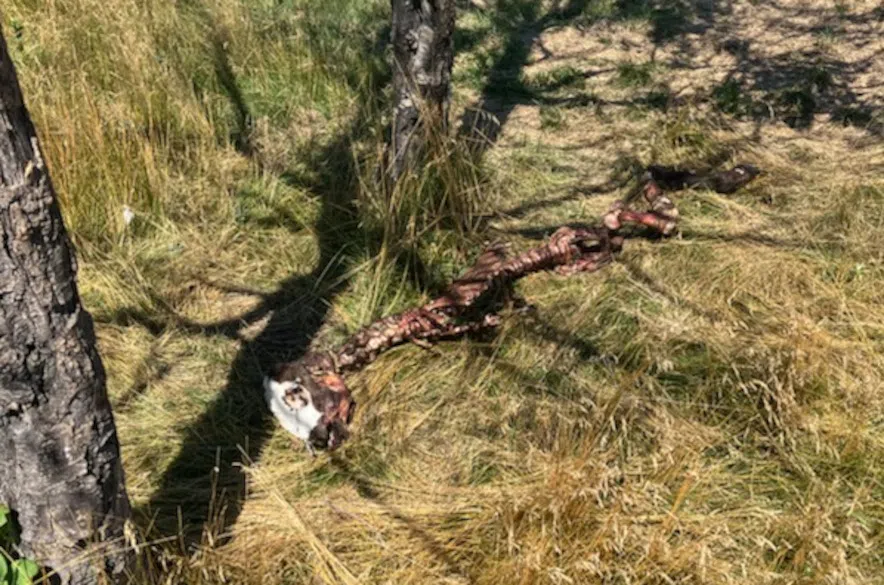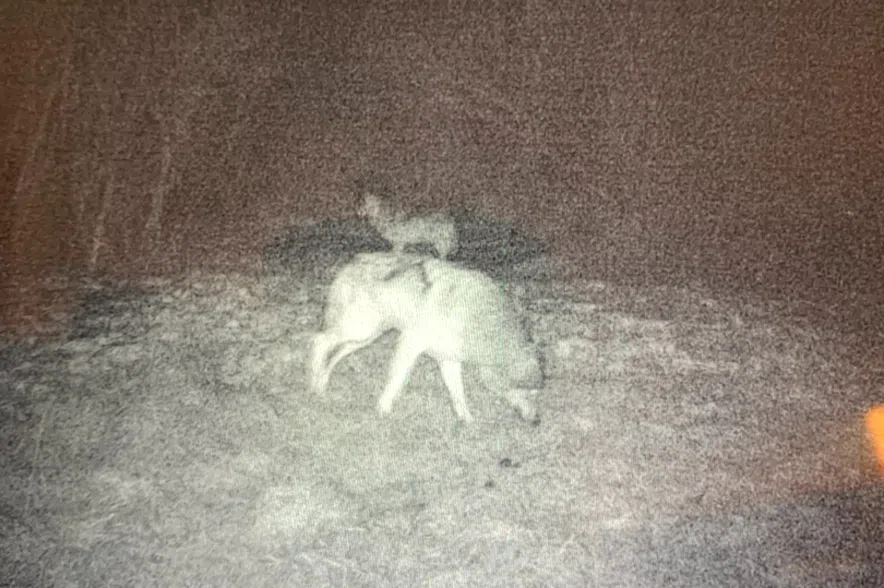Anytime a livestock producer puts their herds out to pasture for the summer, they can expect to lose a few.
But some producers in the Kamsack area, near the Manitoba border, are seeing losses in the double-digits – which they believe is due to wolves.
Amanda Burback remembers one cow of theirs that was attacked.
Her husband was out in the pasture looking at the cow one day and the animal was distinctive because of the white stripe on its face. The next day, they got a call and pictures of what was left of the cow.
“There were two hind legs, a spine, a ribcage and her head left. And (they) only … knew it was her because … the hide was still on her face, and they could see the black with the white stripe,” explained Burback.
She believes the only thing that could do that kind of damage in one night is a pack of wolves.

The carcass of a cow that was believed to have been killed and stripped in one night by wolves. (Amanda Burback/Submitted)
Burback and her husband run Chadwick and Amanda Burback Farms Inc. near Togo, which is right at the Manitoba border southeast of Kamsack.
Burback said there have always been wolves in the area. The Burbacks are just a little ways south of Duck Mountain Provincial Park, so there’s a lot of valleys, trees and bush.
She believes there’s less elk and moose in the area now, so the wolves are looking for other prey and have settled on cattle.
In 2022, Burback said they lost nine calves out of their own pasture and last year they lost 10. She said they’ve always lost a few in their valley land but nothing like these numbers.
Listen to Amanda Burback on Behind the Headlines
“We’ve had animals that have been hit by lightning; you find them because their bodies are there,” she said. “We’ve had animals that have been stuck in the mud and we find them alive; we pull them out and away we go. Sometimes we find them not (alive) but we know they were stuck in the mud.”
Losing that many calves is a big hit. Burback said these days a calf can go for as much at $2,000, so losing nearly 20 in a matter of two years could have been tens of thousands of dollars.
“Here are these wolves out there, eating my paycheque,” said Burback.
Others are losing animals too. Brad Knutson farms between Norquay and Pelly and is a councillor for the RM of Keys.
He said the wolf problem has popped up in just the last three or four years.
“I’m 64 and I don’t think I’d seen a live wolf in my life until the last few years,” said Knutson.
He lost three calves in a community pasture, saying last summer was the worst they’ve seen in the area.
“If it continues at that pasture we’re at now, you start to wonder, ‘Is it worth putting cattle in there?’ And then I’ve had people say, ‘Where are you going to go with them?’ But if it doesn’t make financial sense, what’s the point then?” asked Knutson.
Other community pastures are getting hit as well.
Calder Togo Grazing Inc. lost 45 head in 2023. The company doesn’t believe all of that is to wolves, but it estimates about half or even as much as three-quarters is due to wolf predation.
The pasture also lost 40 head in 2022 – a big jump from 26 in 2021, and 17 in 2020.
Linette Lanski, the secretary/treasurer with the pasture, said it’s definitely become worse. She believes it’s due to the elk population moving around into farmland and the wolves following.
“Because now there’s cattle coming in there with young calves, then the wolves tend to stick around because it’s fairly easy pickings,” said Lanski.
Proving it’s wolves attacking the cattle can be difficult because wolves drag the carcasses away and they’re often never found.
Burback’s sons became frustrated with the losses and went out one day to the pasture.
“They sat down in the pasture with the cows, kind of where they could see trails where there were dog footprints, large footprints. And they sat there just a couple hours and saw eight wolves run by,” she said.
And then the next day, they went out again and saw more wolves.

The carcass of a 400lb calf that was taken down in the morning, believed to be by wolves (Amanda Burback/Submitted)
To try to deal with the problem, the Calder Togo pasture spent several thousand dollars to hire trappers from northern Saskatchewan to come and teach them how to run traps for wolves.
“Wolves are a very hard animal to trap because they’re very intelligent so if they smell a scent, if anything is off of what their usual pattern is, then they will avoid that area,” explained Lanksi.
She said they didn’t catch as many as they might have wanted, but they’re hoping that just the presence of people being out and setting and checking the lines will encourage the wolves to go elsewhere.
The pasture operators got a special permit for the traps last season and are hoping to get it again in the coming year.
With the problem getting worse the last couple of years and with another season ahead, locals are looking for some help.
Knutson’s RM, backed by several others, put up a successful resolution at the recent Saskatchewan Association of Rural Municipalities convention to have the organization lobby the provincial government to implement a bounty for wolves.
Knutson said wolf furs aren’t really worth anything so, without a bounty, there isn’t much incentive for people to come and trap wolves.
He said the pastures are being proactive and trying to do something about it — like the Calder Togo pasture bringing trappers out — but he said it’s hard without a government program.
Saskatchewan Wildlife Federation executive director Darrell Crabbe said the overpopulation of any species is a concern, though the SWF is still waiting on definitive proof in the case of wolves in Saskatchewan.
When it comes to the possibility of a bounty, Crabbe said the SWF is supportive of the concerns from the cattle and stock industry.
“We also want to make sure that any program that’s initiated has sound science behind it and that we can make sure it’s focused on those particular packs and not the wolf population as a whole,” said Crabbe.
He pointed out that trapping has been a pretty effective practice in reducing wolf numbers in the past.
The Ministry of Environment said it is not considering a wolf bounty at this time. In a statement, it encouraged landowners dealing with livestock predation to work with trappers or the Saskatchewan Crop Insurance Corporation (SCIC) to address the issues.
The ministry said trapping has proved to be a more effective method in removing problem wolves from an area.
It wasn’t able to give area-specific data on wolves, but did say “it appears that wolves are not moving substantially outside of their normal range in Saskatchewan.”
Locals in that area near the Manitoba border are also looking for SCIC to help them out with some changes. Livestock predation claims require some sort of proof, like a carcass, but since wolves and other scavengers after the fact often won’t leave any carcass to be found, it can leave some producers hanging.
Knutson’s RM also took a resolution to the SARM convention asking the organization to lobby the government and SCIC to change how it accepts predation claims for these situations.
“Where there’s a third party involved like a pasture manager that’s counting the calves into the pasture, maybe they could look at something better for that, even if there’s nothing to show for it at the end of the day for a carcass,” said Knutson.
SCIC president Jeff Morrow said the company is trying to figure out if there is any other approach it can take in extreme cases like this.
“What we’re trying to do is kind of find the right balance between having responsive programs and acknowledging that when a wolf takes a carcass, sometimes there’s not evidence for us to look at,” he said.
Morrow couldn’t say what a change might look like or how long it would take to work out, though he didn’t think it would be a multi-year process.
In the meantime, producers in the area are in the process of calving and looking ahead to another season where they could lose any number to wolfpacks.
“I feel like it’s already started,” said Burback.
“We have three big dogs in my yard and we border a bush, and there has been a wolf that has been seen almost daily, just kind of standing on the edge of our yard … and my three big dogs are standing out there barking at him and he’s not moving.”
Discover more content on CJME.com











